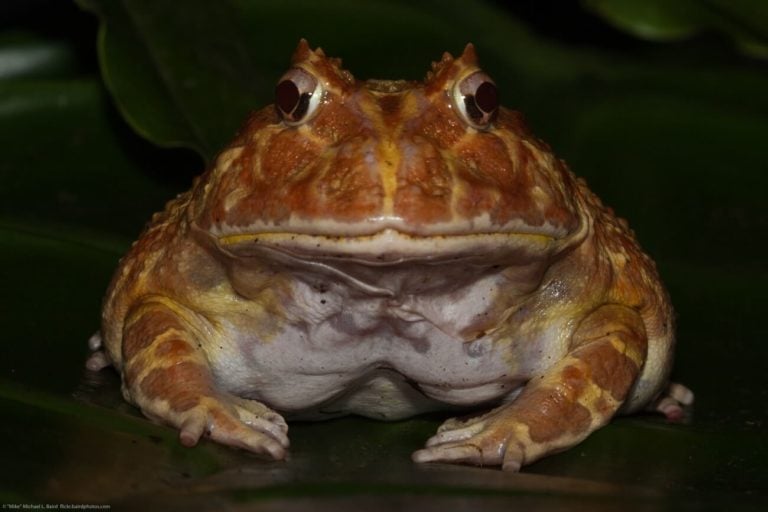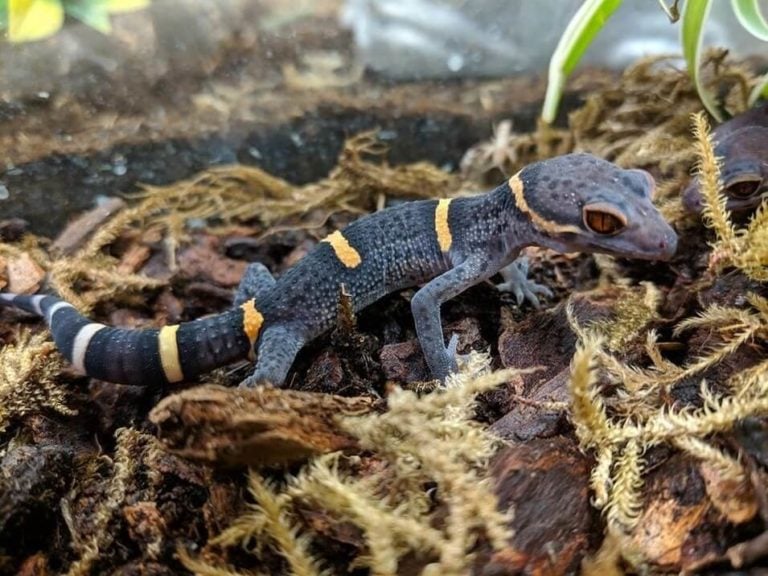Peninsula cooters are a great pet turtle choice for pretty much anyone. They’re very beginner-friendly and a lot of fun to watch!
But even though they’re low-maintenance and easy to care for, it’s still important to understand their baseline requirements if you want them to thrive.
This guide will cover everything you need to know about peninsula cooter care. You’ll learn about their habitat needs, diet, and more.
Table of Contents
Species Summary
The hardy peninsula cooter (Pseudemys peninsularis) is a beautiful turtle species that adapts quite well to life in captivity. Not to be mistaken for the similar-looking River Cooter, peninsula cooters prefer a lax lifestyle in slow-moving waters.
These critters can be found throughout the state of Florida. Natural populations live north of the state too.
Expert Tip: To this day, experts still aren’t quite sure how far north these turtles go.
Peninsula cooters are sizable reptiles that require a well-designed habitat to truly thrive. Because they spend time on both land and water, caring for these creatures allows you to create a beautiful display.
Lifespan
Peninsula cooters have quite a long lifespan when healthy. Many specimens live upwards of 30 years!
However, they require high-quality care to reach their full lifespan. Without the right environmental conditions and food, these turtles can experience a myriad of diseases that will shorten their life.
Appearance & Colors
While they have a similar look to other turtle species endemic to Florida, the peninsula cooter has some distinct physical features.
The first is the shape of the shell.
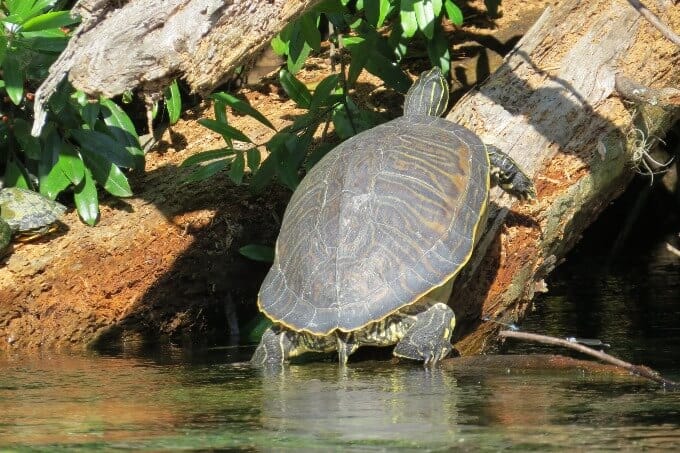
It’s relatively shallow on the perimeter edges. However, the scutes towards the center of the shell are considerably taller. This creates a steep curve and a unique ridge-like shape.
As for color, the turtle is covered in shades of olive green, light green, and yellow. The top of the shell features concentric markings in alternating colors. The bottom is typically solid yellow or tan.
Expert Tip: Some turtles also have ring-shaped markings on the outer bottom scutes.
The head and legs are covered in the same colors. But, the lines are vertical and parallel.
The feet of the peninsula cooter are built for the reptile’s lifestyle. They have sharp claws, which can help provide traction as they dig through the dirt. For swimming, the turtles take advantage of thin webbing between each toe.
Average Size
The average size of an adult peninsula cooter is between 12 and 16 inches. Generally, females are larger and bulkier than males.
The quality of care you give them will significantly impact their maximum size. A good diet and habitat go a long way!
Peninsula Cooter Care
Peninsula cooter care is ideal for new turtle enthusiasts. In general, this species isn’t too difficult to take care of because they’re naturally hardy and are happy to live in community tanks or solitary environments.
As long as you meet their core requirements, these turtles can live long and happy lives. Below are some important care guidelines to follow on your journey.
Tank Size
The most important thing your turtle will need is a sizable habitat.
When they first emerge from the egg, hatchlings are only about an inch in size. This means a small group of hatchlings can do well in a modest 10-gallon tank.
However, peninsula cooters grow fast and will quickly outgrow their hatchling tanks. For adults, you’re going to need a massive enclosure that can hold both water and land.
The recommended enclosure size for adult peninsula cooters is about 48 inches wide, 24 inches deep, and at least 12 inches tall.
Larger tanks are always preferred if you have the room. A large environment provides more swimming and basking space.
Expert Tip: Some owners in temperate climates even go so far as to create outdoor ponds for these turtles.
Recommended Habitat Setup
Peninsula cooters spend their lives on land and in the water. You’ll need to provide both options for your turtle in captivity.
Here are a couple of ways to do this:
The first is to create a full semi-aquatic habitat with a paludarium. Using fine sand or smooth gravel, create the bed of the water portion. Then, create a slope up to a dry basking area.
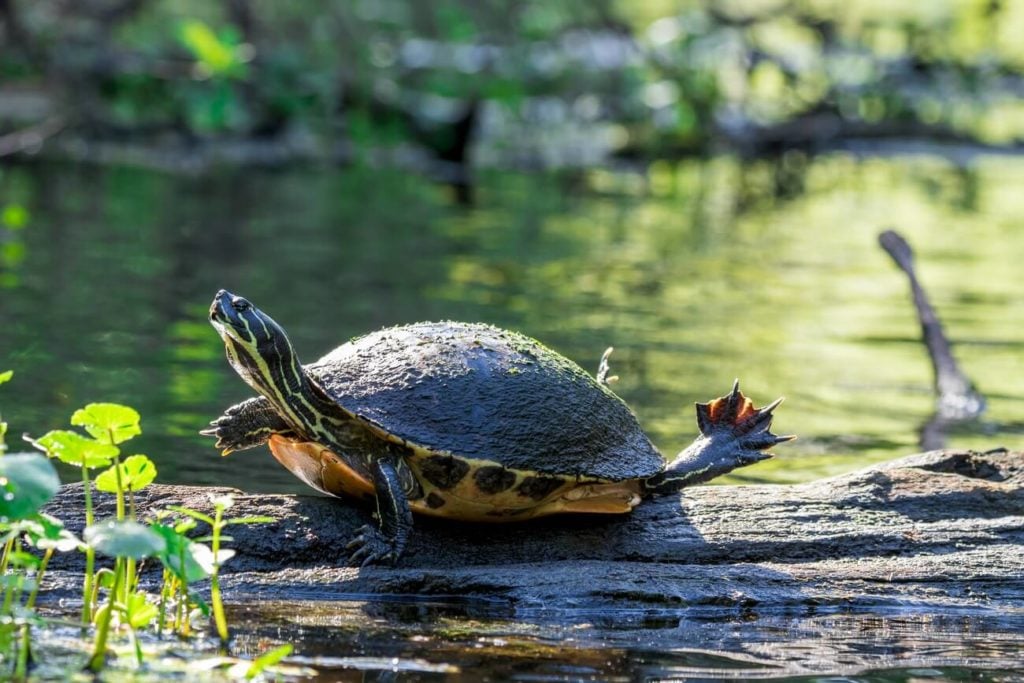
This method takes a lot more work and heavy planning. But, it’s also the most authentic.
An easier alternative would be to use a floating shelf. The shelf follows the waterline, ensuring that your turtle can easily climb onto land when they need to.
Whatever you choose to do, make sure that the land portion is large enough for your turtle to move around. It should support their entire body and have enough space for the reptile to turn around.
Expert Tip: To mimic their natural habitat, add plenty of decorations to the water area. Real and artificial plants can be used. Incorporate both submerged and floating plants to give the turtle places to hide underwater.
Temperature & Lighting
When it comes to temperature and lighting, you’ll need to keep things on the warm side to replicate their environment in the South. Keep ambient temperatures in the 80s (Fahrenheit obviously).
It’s a good idea to create a nice temperature gradient with a basking light. The basking light should point at the land spot you created.
Use your thermometer to keep track of temperatures. The basking area should be between the upper 80s and the lower 90s.
Another thing you’ll need is a UVB lamp. Reptiles like the peninsula cooter are unable to synthesize Vitamin D without sunlight. They need Vitamin D to metabolize calcium, so this isn’t something you can ignore.
It’s best to use a 12 percent UV bulb and keep it on for 10 to 14 hours a day. Make sure that you replace the bulb every six months to keep your turtle in good shape.
Humidity
Peninsula cooters come from swamp-like environments, so humidity is a must! In the tank, humidity levels should be at least 70 percent.
It’s a good idea to use a hygrometer regularly to make sure the humidity is where you want it.
The good news is that this is pretty easy to maintain. The water portion of the enclosure will keep humidity levels high. Just make sure that water isn’t evaporating too quickly and you’ll be fine!
Water
The water conditions of the enclosure are important, too. Water should be slightly cooler than the air. Aim for temperatures between 75 and 80 degrees Fahrenheit.
If you live in a cooler area, the temperature may drop outside of that range during the night. If that’s the case, use a submersible heater to keep things stable.
You’ll also need to invest in a powerful filtration system. Peninsula cooters produce a lot of waste, which can sour the water quality. Most types of turtles are affected by high levels of ammonia and nitrates just like fish.
Expert Tip: Perform weekly water changes and monitor conditions regularly to avoid any issues. This is a very important part of proper peninsula cooter care.
Food & Diet Recommendations
Peninsula cooters are largely herbivores and enjoy a wide range of aquatic plants. The turtles will also accept raw or blanched vegetables (leafy greens are best when it comes to plant-based foods).
For protein, peninsula cooters do best with live or frozen insects. The reptiles enjoy brown crickets, dubia roaches, and even locusts.
Expert Tip: Some owners provide larger meat-based foods, such as mice, fish chunks, and shrimp. However, this should be reserved for larger adults.
Healthy adults can eat every other day. Consider dusting the turtle’s food with calcium supplements and vitamins at least once a week. This will complement the UVB bulbs and help keep the turtle healthy.
Potential Health Issues
Peninsula cooters are relatively healthy pets. However, there are still a few diseases that you should be wary of. Like any other pet, these turtles’ health depends entirely on the level of care you provide.
Failing to address their needs could lead to some serious health issues. Take, for example, metabolic bone disease. This is a common disorder that can affect peninsula cooters and other reptiles.
It can plaque turtles that don’t have access to UVB lights. Their bodies are unable to metabolize calcium, which leads to developmental issues, frail bones, and a host of other issues. For turtles, metabolic bone disease can also affect the quality of the shell.
Make sure to install a UVB lamp in your turtle’s enclosure so that they can receive the benefits they need.
Peninsula cooters can also experience fungal and bacterial infections. These issues often tackle the shell first. Depending on the severity of the infection, you might also see inflammation around the turtle’s face or abscesses under the skin.
Most bacterial and fungal infections are a result of unhygienic living conditions. Clean out the tank regularly and stay on top of the filter’s performance to keep the water quality good.
General Behavior & Temperament
Peninsula cooters are easy-going creatures that have no problem lounging around. They spend most of their time in the water. You’ll often find your turtle hiding among the plants or swimming around.
Despite their weight and size, these turtles are avid swimmers. They will dive down, play in the substrate, and zip around the open swimming area!
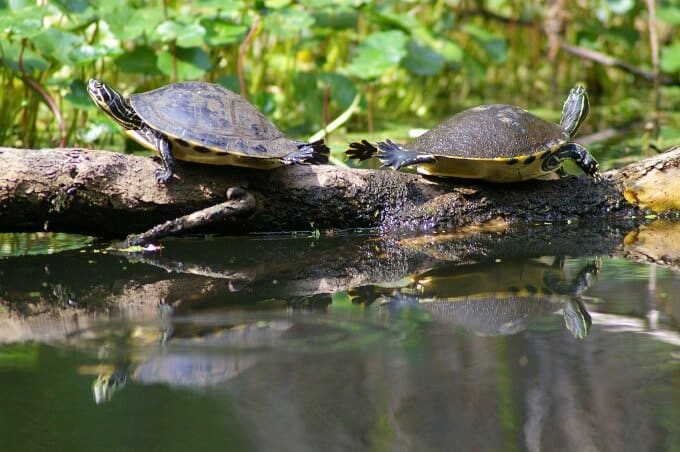
When they’ve had enough swimming for a while, the peninsula cooter will spend hours basking on land.
Unlike other reptiles, peninsula cooters don’t mind sharing the habitat with others. They do very well in small communities. Groups will often bask together.
They’re not known to exhibit any aggressive behavior. But to be on the safe side, make sure that you have a very large enclosure before attempting to keep a group of peninsula cooters together.
In Summary
Peninsula cooter care is nothing to be afraid of. These turtles are one of our favorites because of how low-maintenance they are!
They’re also extremely entertaining to watch. Seeing these little critters zip around underwater never gets old.
If you’re on the fence about getting these turtles we highly recommend giving them a shot. We know so many owners who rave about them, and think you might as well!
Don’t hesitate to reach out if you have any questions that weren’t answered in this care sheet. We’re more than happy to help our readers.

